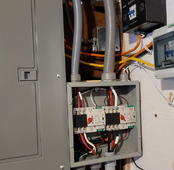Well, no way in hell the little woman here is going to be flipping breakers so I'd go with an ATS for the whole panel if you are afraid of the inverter being an issue (Umm like me). I mounted mine on a DIN rail, left ATS is the EV pedestal, right feeds the panel, top is to the inverters, bottom from the grid, bottom back is the panel feed, all #2. 220v relay ATS was like $60, I have the panel ATS configured with the primary and secondary relays on a straight jumper. The pedestal ATS (EV Charging), the primary is being fed by a control computer, the secondary is tied direct, thus I can software control the source. Mounted it in a 12x12, #2 wire is a pain, panel feed wires (low on the right) are on crimp lugs.
View attachment 189030
It does eat a bit of real estate on the wall, but the switching is 100% seamless. If the inverters stop putting out it just clicks over by magic. These are rotary switches inside, I had a smaller 2-pole one die, and if I re-do it, I'll add in ground on the 4th terminal, to allow me move N-G bonding into the panel on the left if I want to isolate. Thus far I've found this brand of switches to be reliable, but I have TWO spares just in case that Murphy fellow decides to stop by. The two pole that died was a different brand almost identical, with the connections on the right instead of the left, Using it for other override switching to the secondary EV charger in the garage.
I slowly moved EVERYTHING into this panel. It's very full, but at least for me having to manually carry my *ss over and do anything means Murphy is going to make me do just that at the most in-opportune time. So for <$250 worth of wire, switches, a box, and a 100A breaker for my main panel, I can get to it at my convenience. Further, at least for me, it also means I can just let the grid magically pick up the slack when there isn't enough output available from the solar. If the ATS relay fails, or for other maintenance, you can kick the black switch to manual and flip the red knob. During the awful solar days I had in late September, I just shut down the inverter output, and used all the PV to charge batteries for a day and a half. I never had to lift my butt out of the chair . . .
View attachment 189035Just clicked the button.
It just seems to me it's so much simpler just to have a regular old panel, and I still don't see a ton of usefulness with 10 manually activated relay's. I have three more of these ATS's (lower amp) in cheap plastic DIN boxes connected to my oven/range, HWH, and alternate EV, all controllable from a PC, but after about a year, I've discovered, I don't even need it I was afraid 100A was not going to be enough, but I've realized the only loads I have that I'm ever going to want to bypass is EV charging, and the GF is going to run the washer and dryer whenever she feels like it as often as she wants. If she has to flip breakers or calculate loads, I failed in my design.





